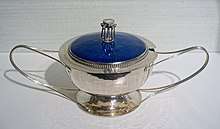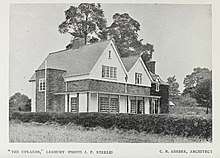Charles Robert Ashbee
Charles Robert Ashbee (17 May 1863 – 23 May 1942) was a British architect and designer who was a prime mover of the Arts and Crafts movement that took its craft ethic from the works of John Ruskin and its co-operative structure from the socialism of William Morris.
Charles Robert Ashbee | |
|---|---|
 C. R. Ashbee by William Strang, 1903 | |
| Born | 17 May 1863 Isleworth, United Kingdom |
| Died | 23 May 1942 (aged 79) Sevenoaks, United Kingdom |
| Resting place | St Peter and St Paul Churchyard, Seal, Sevenoaks District, Kent, United Kingdom[1] |
| Education | Wellington College, King's College, Cambridge |
| Spouse(s) | Janet Elizabeth Forbes (1877–1961) |
| Children |
|
.jpg)
Ashbee was defined by one source as "designer, architect, entrepreneur, and social reformer". His disciplines included metalwork, textile design, furniture, jewellery and other objects in the Art Nouveau and Arts and Crafts genres.[2]
Early life
Ashbee was born in 1863 in Isleworth, the son of businessman and erotic bibliophile Henry Spencer Ashbee. His German-born Jewish mother Elizabeth Jenny Lavi (1842–1919)[3] developed suffragette views, and his well-educated sisters, Frances Mary (1866–1926), Agnes Jenny (1869–1926) and Elsa (1873–1944)[3] were progressive as well.[4] His parents had married in Elizabeth's hometown of Hamburg, Germany on 27 June 1862. Ashbee went to Wellington College and read History at King's College, Cambridge, from 1883 to 1886,[5] and studied under the architect George Frederick Bodley.
Guild and School of Handicraft
Ashbee set up his Guild and School of Handicraft in 1888 in London, while a resident at Toynbee Hall, one of the original settlements set up to alleviate inner city poverty, in this case, in the slums of Whitechapel. The fledgling venture was first housed in temporary space but by 1890 had workshops at Essex House, Mile End Road, in the East End, with a retail outlet in the heart of the West End in fashionable Brook Street, Mayfair, more accessible to the Guild's patrons. The School closed in 1895, which Ashbee blamed on "the failure of the Technical Education Board of the L.C.C. to keep its word with the School Committee and the impossibility of carrying on costly educational work in the teeth of state aided competition."[6] The following year the L.C.C. opened the Central School of Arts and Crafts. In 1902 the Guild moved to Chipping Campden, in the picturesque Cotswolds of Gloucestershire, where a sympathetic community provided local patrons, but where the market for craftsman-designed furniture and metalwork was saturated by 1905. The Guild was liquidated in 1907. One of Ashbee's pupils in Mile End was Frank Baines, later Sir Frank, who was enormously influential in keeping Arts and Crafts alive in 20th-century architecture.

The Guild of Handicraft specialised in metalworking, producing jewellery and enamels as well as hand-wrought copper and wrought ironwork, and furniture. (A widely illustrated suite of furniture was made by the Guild to designs of M. H. Baillie Scott for Ernest Louis, Grand Duke of Hesse at Darmstadt.) The School attached to the Guild taught crafts. The Guild operated as a co-operative, and its stated aim was to:
seek not only to set a higher standard of craftsmanship, but at the same time, and in so doing, to protect the status of the craftsman. To this end it endeavours to steer a mean between the independence of the artist— which is individualistic and often parasitical— and the trade-shop, where the workman is bound to purely commercial and antiquated traditions, and has, as a rule, neither stake in the business nor any interest beyond his weekly wage.[7]
Ashbee himself often designed objects to be made of silver and other metals: belt buckles, jewellery, cutlery and tableware, for example.[8]
Other work

As an architect, he was willing to do complete house design, including interior furniture and decoration, as well as items such as fireplaces. In the 1890s he renovated The Wodehouse near Wombourne for Colonel Shaw-Hellier, commandant of the Royal Military School of Music, adding a billiard room and chapel, amid many external changes. Shaw-Hellier commissioned him in 1907 to build the Villa San Giorgio in Taormina, Sicily,[9] as a little island of England in Italy, hence the name of the patron saint.[10] His biographer Fiona MacCarthy judges it "the most impressive of Ashbee's remaining buildings";[11] it is run as the Hotel Ashbee.[12]
He also designed buildings in Budapest and London.[8]
Ashbee was involved in book production and literary work. He set up the Essex House Press after Morris's Kelmscott Press closed in 1897, taking on many of the displaced printers and craftsmen. Between 1898 and 1910 the Essex House Press produced more than 70 titles. Ashbee designed two type faces for the Press, Endevour (1901) and Prayer Book (1903), both of which are based on Morris' Golden Type.[13]
In 1906, Ashbee published "A Book of Cottages and Little Houses" and, in 1909, "Modern English Silverwork".[8]
In 1924, after concluding a job as civic advisor to the city of Jerusalem, Ashbee wrote a report titled "Jerusalem, 1920-1922, Being the Records of the Pro-Jerusalem Council During the First Two Years of the Civil Administration".[14] The book was reprinted in 2017.[15]
Ashbee wrote two utopian novels influenced by Morris, From Whitechapel to Camelot (1892) and The Building of Thelema (1910), the latter named after the abbey in François Rabelais' book Gargantua and Pantagruel.[16]
Ashbee also founded the Survey of London. The Oxford Reference (Oxford University Press) provides this summary: "Mindful of the huge losses of historic buildings through redevelopment, he began a process of surveying London buildings that led to the important Survey of London volumes."[17]
Personal life
Ashbee was homosexual in a time when homosexuality was illegal. He is thought to have been a member of the Order of Chaeronea, a secret society founded in 1897 by George Ives for the cultivation of a homosexual ethos. He certainly belonged to groups that provided support and understanding to homosexuals.[18]
In 1898, to cover his homosexuality, he married the daughter of a wealthy London stockbroker, Janet Elizabeth Forbes (1877–1961), to whom he admitted his sexual orientation soon after she accepted his proposal.[19] After 13 years of rocky marriage, which included a serious affair by Janet,[19] they had four children: Mary, Helen, Prue and Felicity. Mary Ashbee, later Ames-Lewis (1911–2004) was born at Chipping Camden, Gloucestershire. Jane Felicity Ashbee (1913–2008), Helen Christabel Ashbee, later Cristofanetti (1915–1998) and Prudence Margaret Ashbee (1917–1979) were all born at Broad Campden, Gloucestershire.[20]
He was influenced in his life by the theories of homosexuality developed by Edward Carpenter.[21]
Later life
In 1918 he was appointed civic adviser to the British Mandate of Palestine, overseeing building works and the protection of historic sites and monuments as the chairman of the Pro-Jerusalem Society.[22][23] He summoned his family to Jerusalem, where they lived until 1923.
He died in 1942 at Sevenoaks and was buried at St Peter and St Paul's Church in Seal, Kent, where he was church architect.[24] The internal screen for the church tower was designed by Ashbee.
His papers and journals are at King's College.[25]
Legacy
The East End Preservation Society has presented an annual CR Ashbee Memorial Lecture since 2015.[26]
- 2015 - Oliver Wainwright on the Seven Dark Arts of Developers
- 2016 - Rowan Moore on The Future of London
- 2017 - Maria Brenton, Rachel Bagenal and Kareem Dayes on Hope in the Housing Crisis.
- 2018 - The Gentle Author of the Spitalfields Life blog on CR Ashbee in the East End.[27]
See also
- Birmingham Guild and School of Handicrafts, which was modelled on Ashbee's Guild and School of Handicraft.
References
- http://www.historygraphicdesign.com/index.php/the-industrial-revolution/the-arts-and-crafts-movement/378-klingspor-type-foundry
- https://www.bloomsburydesignlibrary.com/person?docid=iid-bdl-1220, Charles Robert Ashbee
- "Ancestry - Elizabeth Jenny Lavi".
- The Observer review by Rachel Holmes of a biography of his father, 25 February 2001. The Erotomaniac by Ian Gibson, Faber
- "Ashbee, Charles Robert (ASBY8.83 billion)". A Cambridge Alumni Database. University of Cambridge.
- Stuart MacDonald, A Century of Art and Design Education, Lutterworth Press, 2005
- "Archived copy". Archived from the original on 20 September 2005. Retrieved 15 September 2005.CS1 maint: archived copy as title (link)
- http://www.charles-robert-ashbee.com/, Charles R. Ashbee
- RIBA archive drawings
- MacCarthy, Fiona. The Simple Life: C.R. Ashbee in the Cotswolds. University of California Press, 1981. Most of chapter 7, "The death of Conradin"
- MacCarthy, Fiona. The Simple Life: C.R. Ashbee in the Cotswolds. University of California Press, 1981. p 161
- https://www.theashbeehotel.com/history/, History
- Macmillan, Neil. An A-Z of Type Designers. Yale University Press, 2006 (pg. 37)
- https://archive.org/details/jerusalem192019200ashbuoft, Jerusalem, 1920-1922, being the records of the Pro-Jerusalem Council during the first two years of the civil administration; by Ashbee, C. R. (Charles Robert), 1863-1942
- https://www.amazon.com/Jerusalem-1920-1922-Records-Pro-Jerusalem-Administration/dp/1330509552, (Classic Reprint) Paperback – 1 December 2017
- MacCarthy, Fiona. The Simple Life: C.R. Ashbee in the Cotswolds. University of California Press, 1981 (pg. 140)
- https://www.oxfordreference.com/view/10.1093/oi/authority.20110803095428112, Charles Robert Ashbee (1863—1942) architect, designer, and social reformer
- https://books.google.ca/books?id=1lOjhlQuGPQC&pg=PA56&dq=ashbee+Order+of+Chaeronea,&hl=en&sa=X&ved=0ahUKEwjMwKGm3fTkAhUJ5awKHQauB6cQ6AEIKjAA#v=onepage&q=ashbee%20Order%20of%20Chaeronea%2C&f=false, C.R. Ashbee: Architect, Designer & Romantic Socialist, page 56
- Stummer, Robin (8 August 2008). "Felicity Ashbee: Memoirist of the Arts and Crafts era". Retrieved 10 July 2019.
- "Ancestry - Janet Elizabeth Forbes".
- MacCarthy, Fiona. The Simple Life: C.R. Ashbee in the Cotswolds. University of California Press, 1981 (pg. 23)
- Jerusalem, 1918–1920: being the records of the Pro-Jerusalem Council during the period of the British military Administration. London: J. Murray, 1921.
- Jerusalem, 1920–1922: being the records of the Pro-Jerusalem Council during the period of the British military Administration. London: J. Murray, 1924.
- St Peter and St Paul's Church, Seal, Kent
- Janus: at janus.lib.cam.ac.uk
- "East End Preservation Society". www.facebook.com. Retrieved 10 October 2018.
- "The CR Ashbee Lecture 2018 | Spitalfields Life". spitalfieldslife.com. Retrieved 10 October 2018.
Further reading
- Crawford, A. 1986. C.R. Ashbee, Architect, Designer & Romantic Socialist (Yale University Press)
- Fiona MacCarthy. 1981. Simple Life: C.R. Ashbee in the Cotswolds (University of California Press)
External links
| Wikisource has original works written by or about: Charles Robert Ashbee |
| Wikimedia Commons has media related to Charles Robert Ashbee. |